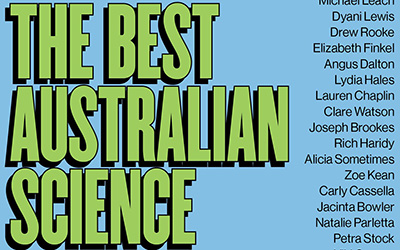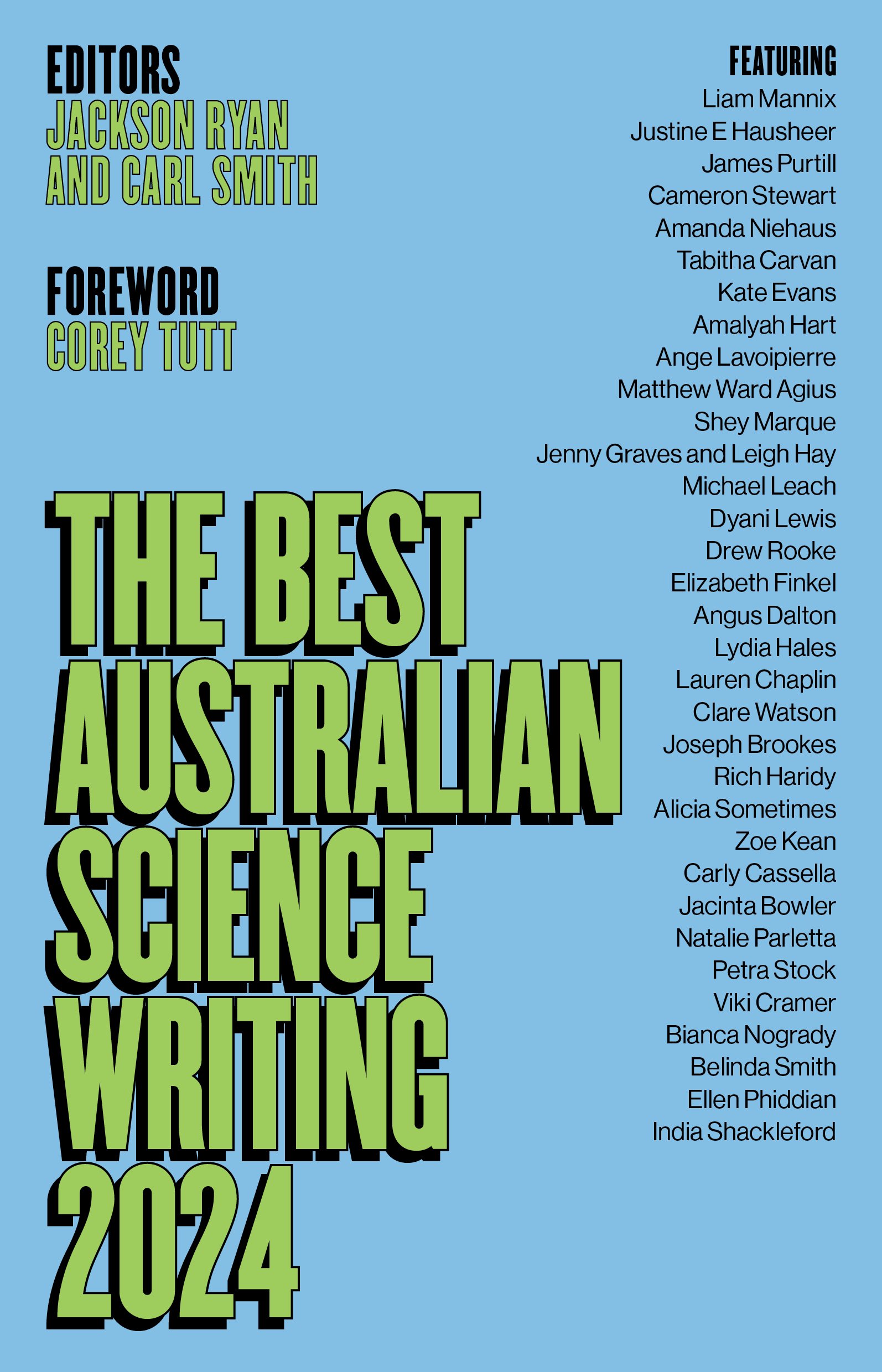
- Free Article: No
- Contents Category: Science
- Review Article: Yes
- Article Title: Force-feeding
- Article Subtitle: The trap of equating opinion with fact
- Online Only: No
- Custom Highlight Text:
In her essay ‘This Little Theory Went to Market’ – one of more than thirty pieces included in The Best Australian Science Writing 2024 – Elizabeth Finkel undertakes a pinpoint dissection of the two prevailing theories about the origins of SARS-CoV-2 (Covid-19): ‘natural origin versus a lab leak’. What Finkel is at pains to point out in her essay is that science ‘advances ... on the “weight of evidence”’ and that, based on that weight of evidence, SARS-CoV-2 ‘was made not in the laboratory of man, but in nature’. Finkel’s essay is essential reading not only for her meticulous analysis of the evidence – peer-reviewed papers and US intelligence sources – but also for her approach: ‘I do not blindly trust scientists. My lodestone is the scientific method itself.’
- Featured Image (400px * 250px):

- Alt Tag (Featured Image): Diane Stubbings reviews ‘The Best Australian Science Writing 2024’ edited by Jackson Ryan and Carl Smith
- Book 1 Title: The Best Australian Science Writing 2024
- Book 1 Biblio: NewSouth, $32.99 pb, 317 pp
- Book 1 Cover Small (400 x 600):

- Book 1 Cover (800 x 1200):

- Book 1 Readings Link: https://www.readings.com.au/product/9781761170157/the-best-australian-science-writing-2024--2024--9781761170157#rac:jokjjzr6ly9m
Failure to adhere to the underlying parameters of science when discussing Covid has allowed assorted fictions and conspiracies to run rampant. Exacerbating this spread of falsehoods, Finkel implies, is an ignorance of the scientific method and a consequent inability to differentiate science from propaganda or even abject nonsense. She warns that ‘[j]ournalists need to examine their process. Rather than wedding themselves to a particular narrative, they can do no better than taking a page from the scientific method.’
The warning is one that Jackson Ryan and Carl Smith, the editors of this volume, should perhaps have heeded. For every gem such as Finkel’s, there are essays that are, plainly put, dross, any note of authentic science subsumed by well-meaning speculation and memoir-like musings. Making science more accessible is a laudable aim, but what this volume demonstrates is that there is a fine line between making science more accessible and rendering it as claptrap.
The better essays in The Best Australian Science Writing 2024 underpin their arguments with logic and reason. Natalie Parletta surveys the life cycle of the mountain ash, demonstrating how its ecosystem is endangered by droughts and bushfires of increasing intensity and frequency. Lose the mountain ash and we risk losing over forty species of vertebrates which depend on it for shelter, including ‘Leadbetter’s possum ... the yellow-bellied glider, and ... the sooty owl’. Similarly concerned with the ecological damage caused by extreme weather, Kate Evans examines the interdependence of bogong moths and mountain pygmy possums, revealing that Zoos Victoria has developed ‘bogong bikkies’ – a mixture of ‘macadamia nuts, coconut oil, mealworms, egg white and vitamins’ – which keep the possums from starving when their preferred bogong-moth breakfast is in short supply.
In his essay on the evolution of climate change modelling, Drew Rooke’s approach to the science is as precise and exacting as Finkel’s. Rooke takes us all the way back to the mid-nineteenth century and the work of Eunice Foote, who conducted the first experiments demonstrating the effect of increased sunlight on carbon dioxide. From the earliest computer models in the 1950s – using the ENIAC computer, which weighed almost twenty-five tonnes and had a computing power 1,300 times less than a modern mobile phone – to current models, whose code runs to 18,000 pages, Rooke shows that while climate models are ‘imperfect, incomplete and still have bugs in them, they nonetheless make useful, good predictions. And those predictions have been getting better over time.’
Other creditable essays examine how the business model of Big Pharma might be circumvented in the name of public health, the development of treatments for childhood cancer, and the recent discovery that female lyrebirds are as capable as males of using song and mimicry for survival (‘it’s worth remembering that if a female bird isn’t singing, it doesn’t mean she can’t’). One paper includes the unexpected fact that several of the exotic specimens collected during the 1800 French expedition to Australia were, on the return voyage, force-fed to maintain their health: ‘We gave [the emus], and the sick kangaroo likewise, wine and sugar.’
However, in striving to personalise the science, too many of the essays in this collection fall into the trap of equating opinion with fact. An essay that explores a spurious connection between long Covid and psychedelic drugs is one example, with much of the piece devoted to the exploits of a ‘psychonaut’ who self-tests their theories and who seems to know nothing of either experimental controls or statistical significance.
This erosion of the scientific method is also worryingly evident in the preface (Corey Tutt) and introduction to the volume. Here, a questionable equivalence is established between science and storytelling, between science and ‘knowledge systems’. This is notably the case with respect to Indigenous knowledges, the proposition being that STEM should incorporate those ways of ‘knowing and being’ particular to Aboriginal culture; further, that science has a responsibility to rewrite historical wrongs, as Joseph Brookes reports in his essay, by recognising ‘Indigenous knowledge as an equal, not as myths and legends and stories’. His essay might persuade us of a complementarity between Indigenous knowledge and science, but not a correspondence.
The problem with assertions like Brookes’s, and with the tenor of the introductory material generally, is that it adheres to a narrative that is embedded more in politics than science. Assertions are made without any clear definition of what is meant by ‘knowledge systems’, nor of how such systems are ‘scientific’ in their approach to knowledge. Similarly, no clear distinction is made between ‘storytelling’ that is simply marinated in science and the accurate communication of scientific theory (remembering that science encompasses the best available theories by which the universe might be explained).
Institutes such as the British Science Council remind us that science is more than just the reinforcement of personal and cultural truths, or the transmission of opinions, learned or otherwise. Science is ‘the pursuit and application of knowledge and understanding of the natural and social world following a systematic methodology based on evidence’ (my emphasis). Dismissing such definitions as too ‘Eurocentric’, as Brookes does, could be viewed as a case of throwing the baby out with the bathwater. More egregiously, it plays into the hands of those who equate science with doctrine; those who, by suggesting that science is an object of faith whose findings can be embraced or dismissed according to that faith, not only misrepresent but disrepresent what it means to be ‘scientific’.


Comments powered by CComment